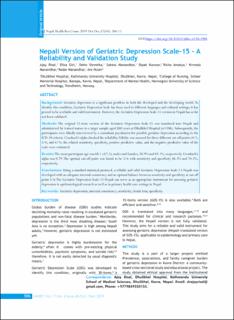| dc.contributor.author | Risal, Ajay | |
| dc.contributor.author | Giri, E | |
| dc.contributor.author | Shrestha, Oshin | |
| dc.contributor.author | Manandhar, Sabina | |
| dc.contributor.author | Kunwar, Dipak | |
| dc.contributor.author | Amatya, R | |
| dc.contributor.author | Manandhar, Nirmala | |
| dc.contributor.author | Manandhar, Kedar | |
| dc.contributor.author | Holen, Are | |
| dc.date.accessioned | 2022-10-11T14:45:27Z | |
| dc.date.available | 2022-10-11T14:45:27Z | |
| dc.date.created | 2021-01-05T11:07:34Z | |
| dc.date.issued | 2020 | |
| dc.identifier.citation | Journal of Nepal Health Research Council. 2020, 17 (4), 506-511. | en_US |
| dc.identifier.issn | 1727-5482 | |
| dc.identifier.uri | https://hdl.handle.net/11250/3025427 | |
| dc.description.abstract | Background: Geriatric depression is a significant problem in both the developed and the developing world. To identify this condition, Geriatric Depression Scale has been used in different languages and cultural settings; it has proved to be a reliable and valid instrument. However, the Geriatric Depression Scale-15 version in Nepali has so far not been validated.
Methods: The original 15-item version of the Geriatric Depression Scale-15 was translated into Nepali and administered by trained nurses to a target sample aged ?60 years at Dhulikhel Hospital (n=106). Subsequently, the participants were blindly interviewed by a consultant psychiatrist for possible geriatric depression according to the ICD-10 criteria. Cronbach’s alpha checked the reliability. Validity was assessed for three different cut-off points (4/5, 5/6, and 6/7); the related sensitivity, specificity, positive predictive value, and the negative predictive value of the scale were estimated.
Results: The mean participant age was 68.1 (±7.2); males and females, 50.9% and 49.1%, respectively. Cronbach’s alpha was 0.79.The optimal cut-off point was found to be 5/6 with sensitivity and specificity 86.3% and 74.5%, respectively.
Conclusions: Using a standard statistical protocol, a reliable and valid Geriatric Depression Scale-15-Nepali was developed with an adequate internal consistency and an optimal balance between sensitivity and specificity at cut-off point 5/6.The Geriatric Depression Scale-15-Nepali can serve as an appropriate instrument for assessing geriatric depression in epidemiological research as well as in primary health care settings in Nepal.
Keywords: Geriatric depression; internal consistency; sensitivity; South Asia; specificity. | en_US |
| dc.language.iso | eng | en_US |
| dc.publisher | Nepal Health Research Council | en_US |
| dc.rights | Navngivelse-Ikkekommersiell 4.0 Internasjonal | * |
| dc.rights.uri | http://creativecommons.org/licenses/by-nc/4.0/deed.no | * |
| dc.title | Nepali Version of Geriatric Depression Scale-15 - A Reliability and Validation Study | en_US |
| dc.title.alternative | Nepali Version of Geriatric Depression Scale-15 - A Reliability and Validation Study | en_US |
| dc.type | Peer reviewed | en_US |
| dc.type | Journal article | en_US |
| dc.description.version | publishedVersion | en_US |
| dc.source.pagenumber | 506-511 | en_US |
| dc.source.volume | 17 | en_US |
| dc.source.journal | Journal of Nepal Health Research Council | en_US |
| dc.source.issue | 4 | en_US |
| dc.identifier.doi | 10.33314/jnhrc.v17i4.1984 | |
| dc.identifier.cristin | 1865378 | |
| cristin.ispublished | true | |
| cristin.fulltext | original | |
| cristin.qualitycode | 1 | |

